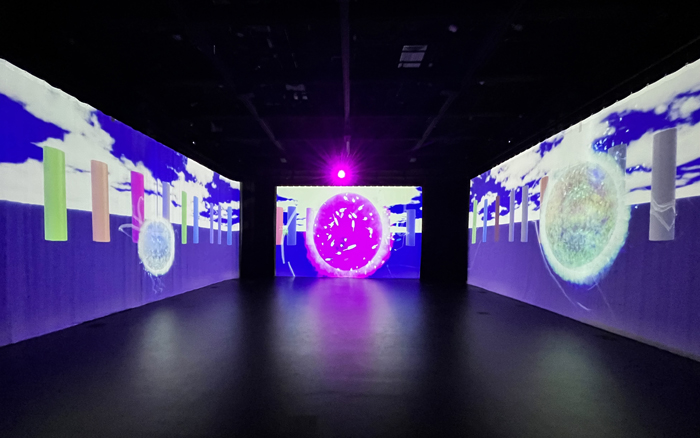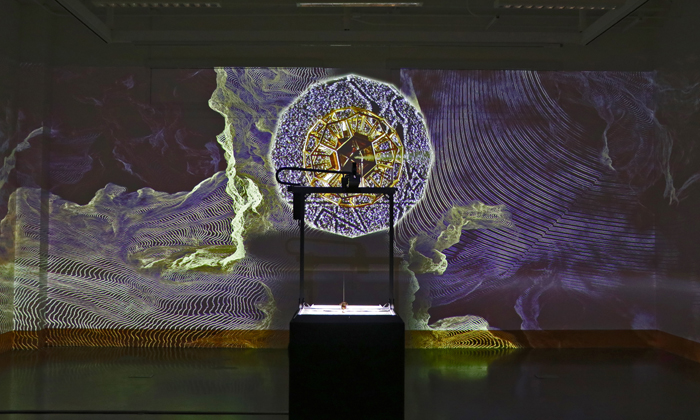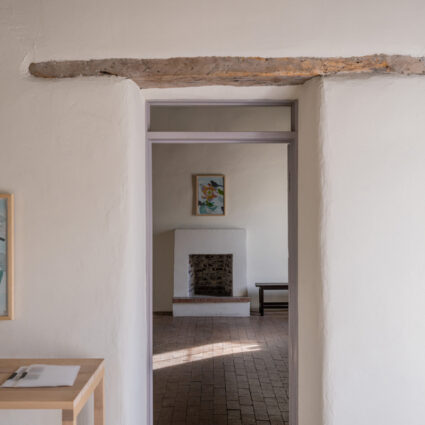Denver Digerati, under the direction of executive director and chief curator Sharifa Lafon, looks to change up its digital arts and educational programming in 2023.

DENVER—Denver Digerati was established in 2011 as an organization that operated under the umbrella of the Denver Theatre District, and primarily screened animated content on LED billboards during their Friday Flash programs. Five years later, it launched the Supernova Digital Animation Festival, an event that celebrates digital animation and motion art during the month of September. The festival soon transformed into the organization’s primary focus, attracting an international audience of new-media aficionados and art lovers.
Denver Digerati became a standalone non-profit in 2019, specializing in motion art, new media, and animation. It hosts innovative digital presentations and provides key support for a growing network of creators working with cutting-edge technologies. Under the new leadership of Sharifa Lafon—who quickly ascended from a board member to executive director and chief curator—the organization is undergoing extensive changes, ranging from a rebranding of its marquee event to expanding its educational programs and community partnerships.
After moving Supernova to an exclusively online format during the pandemic, the festival returned to an in-person incarnation this year, screening content at the Sie Film Center and the Buell Theater as well as the Dairy Arts Center in Boulder. The 2022 program included work by Zongbo Jiang, Young Joo Lee, João Pedro Oliviera, and Marcella Moliner in a showcase that features massive digital artworks projected onto the sides of buildings. “In addition to film screenings,” says Lafon, “Denver Digerati commissions artists for Night Lights Denver and activates a single day takeover of LED billboards in the Denver Theatre District.”
While the September film festival remains the non-profit’s flagship project, Lafon wants to alter the trajectory of the program. At the onset of 2023, the non-profit will implement “a visual rebrand, and the organization is dropping the name Supernova.”
Moreover, Lafon notes that “our education program experienced a lot of growth in the last year, including guest spots in public schools and a workshop with Children’s Hospital over the summer. We are thrilled about a pilot we are developing for 2023 and are actively applying for funding.”

Of course, moving into the educational sector poses a new set of challenges for the organization. “The schools I go into are super excited to have me,” Lafon says, but many of them don’t have the technological infrastructure she expected. Some schools even lacked computers.
“[You] have to problem-solve and be innovative [in order] to teach time-based media when you don’t have the adequate technology to do so. We use flipbooks and cellphone cameras for stop-motion films; there’s a lot of education around traditional artmaking. But moving into the construction of a timeline is a bit of a leap. So that’s what I’ve been working on the previous year. Going forward, education will be a bigger focus for the organization.”
As a remedy for the dearth of computer-based and technological infrastructure, Lafon wants to create a “mobile tech unit” that will allow for “more DIY, guerilla-type activation, where we can go out and do something that’s fun and engaging for participants.” Having such flexibility would provide Denver Digerati with the ability to offer “more pop-up opportunities for the community, [where] we can run an education program, then [screen content on-site with] an exterior projector that has high-quality capabilities.”
In addition to developing the non-profit’s educational focus, Lafon wants to expand its community allegiances. “We have a very strong international network,” she says, but wants to more thoroughly engage Denver-area artists and people working in digital media.

Lafon, who first joined Denver Digerati in March 2020 as a board member after leaving a curatorial position at the Center for the Arts in Evergreen, mentions several digital artists working locally that she admires, such as University of Colorado Boulder MFA candidate Andy DiLallo, PhD candidate Paulus van Horne, and CU Boulder alumni Ryan Wurst, who recently moved back to the state to become an assistant professor of gaming and immersive media at Colorado State University Pueblo. To Lafon, these and other creators demonstrate the vitality of both the art form and its strength within the region.
“Chris Coleman and Laleh Mehran teach the University of Denver’s emergent digital practices program and they are both phenomenal artists and dedicated supporters of the digital art community,” says Lafon. “Cherish Marquez, who is also on my board, is a graduate [of DU’s emergent digital practices program]. I love her thinking around the work she’s creating. It’s a joy to watch her develop because she’s evolving so quickly as an artist. She’s just fabulous and a strong curator as well.
“I serve on the board of Tilt West with Joel Swanson, an amazing artist and educator, who is an associate professor at the [Alliance for Technology, Learning, and Society, or ATLAS] Institute at CU Boulder. Their program is another producing high-level work right here in our state.”
As far as trends within the digital content, animation, and motion arts world that Lafon finds compelling, she looks to “post-humanism and cybernetics as a framework. The notion of existing in a space without a body is fascinating to me. There is a real opportunity to be genderless and bodiless in a digital space. Digital work presents an opportunity to break out of traditional binaries,” Lafon says, “and allows us to talk more about cyborgs, gender, the body, and able-bodyism.”
Ultimately, she believes the digital arts and “the humanities, in general, give us a greater capacity for empathy and the ability to think about issues more critically. And that is something that we need more than ever.”





